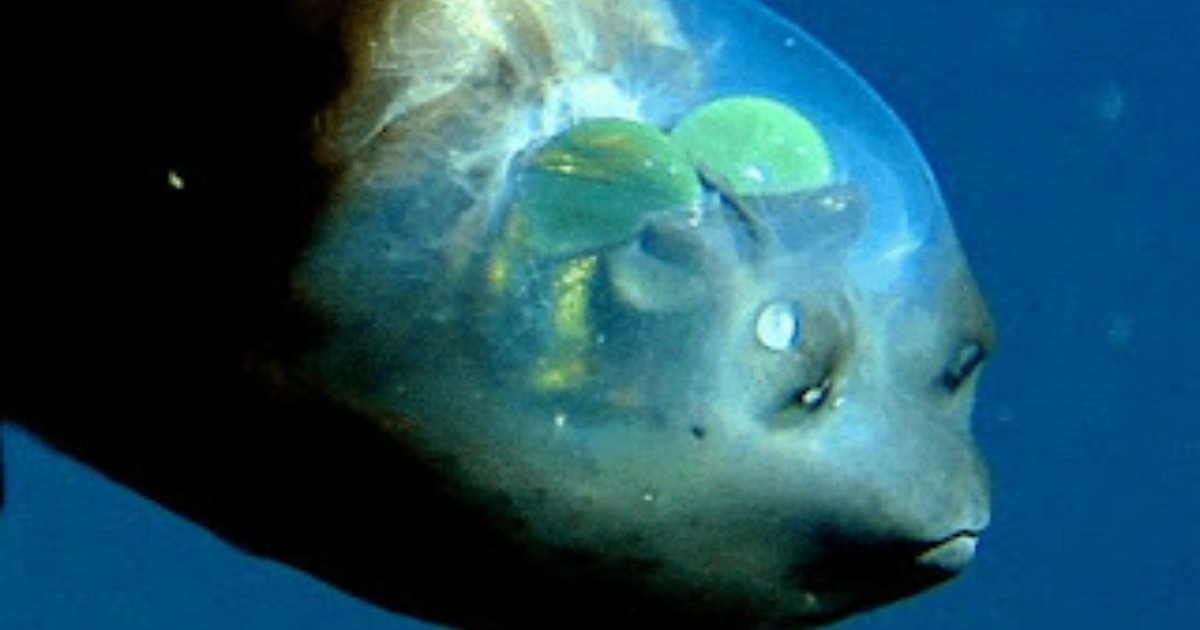When envisioning what an extraterrestrial might look like, one might imagine a creature with a translucent head and large, piercing green eyes.
Remarkably, these seemingly otherworldly traits can be found right here on Earth, lurking in the depths of the ocean. Enter the barreleye fish, a mysterious and peculiar species that embodies the intriguing aspects of deep-sea life. Filmed by MBARI (Monterey Bay Aquarium Research Institute). Other Deep sea creatures such as Vampire Squid was also Fimed.
Appearance
The barreleye fish, with its dark gray or black coloring, is relatively small, measuring up to six inches in length.
The most captivating feature lies in its eyes—two striking green tubes or barrels that naturally gaze upward, though they can rotate forward to spot potential prey.
A translucent dome-like forehead envelops these mesmerizing eyes, acting as a fluid-filled barrier for protection. Surprisingly, the dark circles that resemble eyes are nares, housing the barreleye’s olfactory organs.
Habitat
Thriving in the ocean’s twilight zone, the barreleye fish calls depths of 2,000 to 2,600 feet it’s home.
In this eerie region, sunlight barely penetrates, creating an environment where unique adaptations are essential for survival. Embracing the darkness, the barreleye employs its glowing green eyes to navigate and forage for food.
Other deep-sea creatures, such as the captivating glass octopus and the elusive vampire squid, also utilize specialized features to thrive in this enigmatic realm.
Reproduction
As solitary creatures, the barreleye fish’s reproductive behavior remains shrouded in mystery. Scientists hypothesize that they engage in pelagic spawning, where eggs and sperm are released into open water, allowing fertilized eggs to disperse.
Feeding
A typical day in the life of a barreleye fish revolves around stealthily hovering in the deep sea, observing the waters above for nourishment. Utilizing their large fins to maintain stability, barreleyes patiently wait for their preferred prey, zooplankton.
Moreover, these cunning fish are believed to cunningly pilfer their meals from siphonophores—elongated jelly-like organisms.
Their translucent domes act as shields, protecting their sensitive eyes from the stinging cells of these potential predators.
Exploring the Unknown
Though the barreleye fish already captivates our imagination, it serves as a reminder that the depths of the ocean conceal countless mysteries. Our understanding of these mesmerizing creatures, alongside numerous other denizens of the deep-sea fishes, is still in its infancy.
As we embark on expeditions into the unknown, we not only satiate our curiosity but also develop the knowledge required to safeguard these unique beings from human impact. Advocating for our ocean’s wildlife, including these wondrously rare deep-sea creatures, is a vital endeavor.
A Closer Look at the Barreleye Fish
Fascinating Facts
Barreleye fish possess tubular rotating eyes inside their transparent heads, granting them unparalleled vision in the darkness. Surprisingly, they are colorblind due to the absence of cone cells responsible for perceiving color.
Thriving in the twilight zone, where sunlight is virtually non-existent, the barreleye’s transparent head was a source of disbelief until its discovery in 2004.
A rare and enigmatic species, the barreleye fish belongs to the Opisthoproctidae family, and only a few sightings have been recorded, making their study challenging.
Species of Barreleye Fish
Javelin spookfish (Bathylychnops exilis): Found in the North Pacific and eastern Atlantic Ocean, reaching a length of 20 inches at a depth of 2,100 feet.
Dolichopteroides binocularis: Inhabiting the Pacific Ocean at depths of 3,100 to 3,900 feet, growing up to 13 inches.
Brownsnout spookfish (Dolichopteryx longipes): A small species measuring 7 inches, residing at depths of 4,000 feet or more.
Opisthoproctus grimaldii: A tropical species found at depths of 984 to 1,300 feet, reaching a size of 7 inches.
Opisthoproctus soleatus: A diminutive species dwelling at depths of 1,600 to 2,300 feet.
Unique Appearance
Barreleye fish from the Macropinna genus showcase a transparent head shield filled with protective fluid, housing their green orb-like eyes.
Their eyes, resembling a brain at first glance, are positioned inside their transparent heads, providing three-dimensional vision, enabling them to look upwards, sideways, and forwards.
With large, flat fins, barreleye fish can remain motionless in the water, floating gracefully in the dark depths.
Habitat and Behavior
The Twilight Zone
Barreleye fish thrive in the mesopelagic to bathypelagic zones, where darkness envelopes the ocean’s twilight zone, and sunlight rarely penetrates.
In this habitat, the fish float gracefully, ever-watchful for jellyfish—their primary prey—using their unique eyes to detect the glow of these delicate organisms.
Predator and Prey
Due to their deep-sea location, little is known about their predators. Larger predatory fish in the deep waters may prey on the barreleye fish, which lacks defensive adaptations.
Barreleye fish are ambush predators, relying on their specialized vision to detect and capture small crustaceans, zooplankton, and mollusks.
Reproduction and Lifespan
Pelagic Spawning
Barreleye fish are pelagic spawners, releasing their eggs and fry into the open water to float until hatching.
The average lifespan of a barreleye fish is approximately 60 years, marking remarkable longevity for a fish species.
Conclusion
The barreleye fish stands as a testament to the wonders hidden beneath the ocean’s surface. With its transparent head, unique vision, and graceful movements, it exemplifies the marvels of deep-sea creatures.
As researchers continue their quest to uncover the mysteries of the deep, let us preserve and protect these enigmatic beings, ensuring their survival for generations to come.
May we cultivate reverence for these alien-like wonders of the deep, cherishing their existence and safeguarding their fragile habitats.



